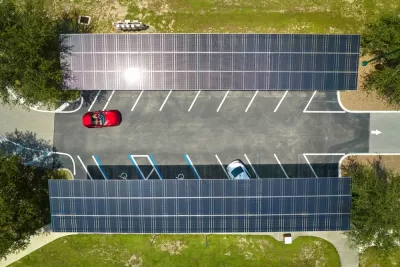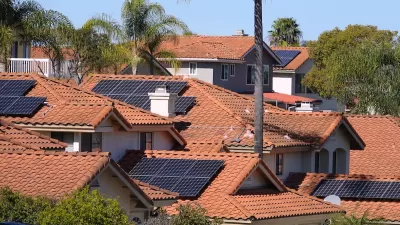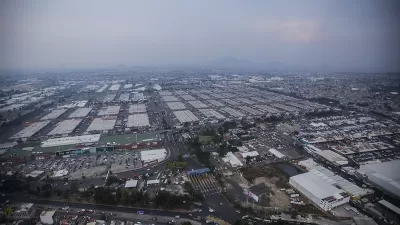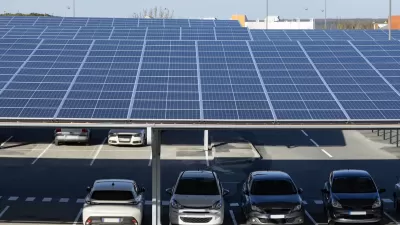Placing solar panels over parking lots has multiple benefits, but higher costs have prevented their widespread adoption in U.S. cities.

“We need to rapidly transition away from fossil fuels to avoid the worst effects of global warming. And, as extreme weather becomes more common, shade and shelter from downpours would be a welcome development for drivers,” writes Andrew Block for CNET. So why isn’t every outdoor parking space covered by solar panels?
Parking lot solar is becoming more common in some parts of the United States like the Southwest, but there are some challenges in retrofitting existing parking lots with solar canopies. According to Tim Powers of Inovateus Solar, “A carport is roughly 40% more expensive compared to a ground mount system.” But carports provide an extra service and can help institutions and businesses with large parking lots lower their carbon footprint. At Michigan State University, 5 percent of campus energy consumption is powered by parking lot solar panels. And it made use of existing development, preserving existing farmland. “Michigan State's installation kept 45 acres of agricultural land in production, a fact Michigan State called out in promoting one of the several awards it won for the array.”
Carport solar could also power electric vehicles, industry experts add. For example, “An average Walmart parking lot could support about 100 electric vehicle chargers if covered in solar panels, Pearce's research found.” Ultimately, while carport solar installations aren’t the most cost-effective way to install solar, they can be a useful solution where land is scarce. Last year, France passed a law requiring solar panels over most parking lots in the country by 2028.
FULL STORY: Why Isn't Every Parking Lot Covered With Solar Panels?

Alabama: Trump Terminates Settlements for Black Communities Harmed By Raw Sewage
Trump deemed the landmark civil rights agreement “illegal DEI and environmental justice policy.”

Planetizen Federal Action Tracker
A weekly monitor of how Trump’s orders and actions are impacting planners and planning in America.

The 120 Year Old Tiny Home Villages That Sheltered San Francisco’s Earthquake Refugees
More than a century ago, San Francisco mobilized to house thousands of residents displaced by the 1906 earthquake. Could their strategy offer a model for the present?

Ken Jennings Launches Transit Web Series
The Jeopardy champ wants you to ride public transit.

BLM To Rescind Public Lands Rule
The change will downgrade conservation, once again putting federal land at risk for mining and other extractive uses.

Indy Neighborhood Group Builds Temporary Multi-Use Path
Community members, aided in part by funding from the city, repurposed a vehicle lane to create a protected bike and pedestrian path for the summer season.
Urban Design for Planners 1: Software Tools
This six-course series explores essential urban design concepts using open source software and equips planners with the tools they need to participate fully in the urban design process.
Planning for Universal Design
Learn the tools for implementing Universal Design in planning regulations.
Clanton & Associates, Inc.
Jessamine County Fiscal Court
Institute for Housing and Urban Development Studies (IHS)
City of Grandview
Harvard GSD Executive Education
Toledo-Lucas County Plan Commissions
Salt Lake City
NYU Wagner Graduate School of Public Service





























